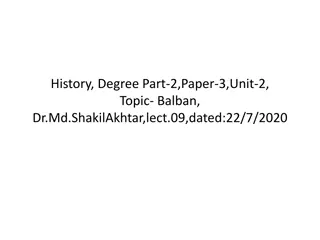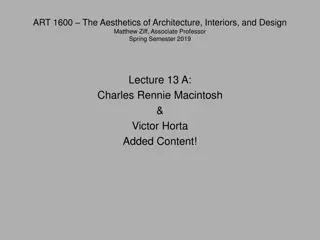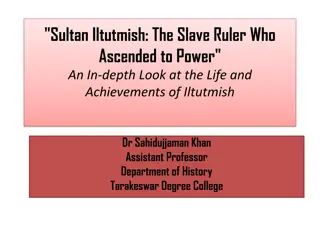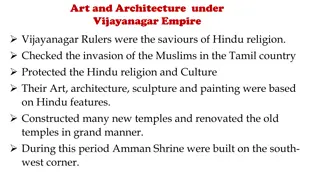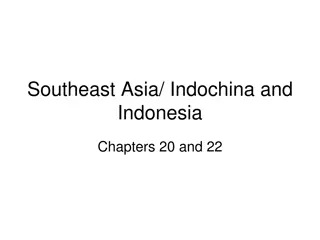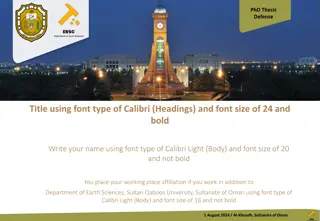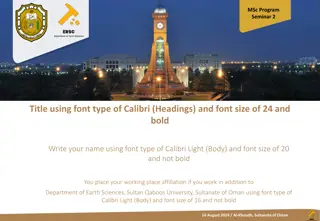Art and Architecture of Delhi Sultanate Period
Art and architecture during the Delhi Sultanate period showcased a unique blend of Indian and Turkish styles, forming the distinctive Indo-Islamic architecture. Prominent structures like Quwat-ul-Islam Mosque, Alai Darwaza, Tomb of Ghiasuddin Tughlaq, Feroz Shah Kotla, and Tughlaqabad Fort exemplified the use of domes and arches in Turkish styles. Qutub Minar, a significant landmark, stands as a testament to the architectural brilliance of the era.
Download Presentation

Please find below an Image/Link to download the presentation.
The content on the website is provided AS IS for your information and personal use only. It may not be sold, licensed, or shared on other websites without obtaining consent from the author. Download presentation by click this link. If you encounter any issues during the download, it is possible that the publisher has removed the file from their server.
E N D
Presentation Transcript
Architecture during Delhi Sultanate Art and architecture of the Delhi Sultanate period was different from the Indian style Indo Islamic style of architecture mingling of the Indian and Turkish styles DOMES AND ARCHES OF Turkish styles well known buildings of this period 1. Quwat- ul Islam mosque, 2. Alai Darwaza, 3. Tomb of GhiasudduinTughlaq, 4. Ferozshahkotla, 5. Tuglaqgabad fort developed as
Qutub Minar was specially made by Qutb-ud- din Aibak, the first Sultan of Delhi, and was finished by his heir Iltutmish It is about 73 metres high and built of marble and red sandstone. It is a five storey building. The stairs of the complex has about 375 steps Qutub Minar was renovated by Firoz Shah, during his reign when it was damaged It was named in honour of QutubuddinBakhtiar Kaki, a saint from Transoxiana who came to live in India and was greatly venerated by Iltutmish.
The Alai Darwaza is the main gate from the southern side of the Quwwat-ul-Islam Mosque in the Qutub Minar complex . Built by Allaudin Khilji the Sultan of Delhi in 1311 AD Alai Darwaza has a domed entrance which is constructed using red sandstone and is adorned with white marble Alai Darwaza is one of the first buildings in India to be built using an Islamic architectural style
Built during the years 1320-25, the tomb of Ghiyas ud din Tughlaq, first ruler of the Tughlaq dynasty, stands like a small fortress directly opposite the Tughlaqabad fort The tomb was built by the Sultan himself, and is a brilliant example of the early Indo Islamic style. The structure sits within a fortified pentagonal enclosure, with the heavily battered walls and characteristic of Tughlaq era buildings. corner turrets
Feroz Shah Kotla was a fortress built by Sultan Feroz Shah Tughlaq to house his version of Delhi city called Ferozabad. A pristine polished sandstone pillar from the 3rd century B.C. rises from the palace's crumbling remains, one of many pillars of Ashoka left by the Mauryan emperor; to Delhi under orders of Firoz Shah Tughlaq of Delhi Sultanate, and re-erected in its present location in 1356.
This third city of Delhi was constructed by GHIYASU D-DIN TUGHLAQ in AD 1321-1325. The fort is renowned for the prescriptions due to which it remains abandoned from ages
These depict the style of Indo -Muslim architecture. The forts were simple but strong. They built arches above the doorways and windows instead of beams, which were used by Indians before the coming of the Muslims.



